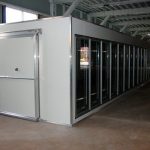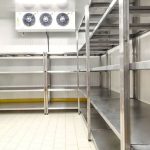How Do Blast Freezers Work?
- 08 December 2015
The dramatic terminology assigned to blast freezers suggests a dynamic process, but the technology is really all about simplicity, simplicity and tiny crystals. In food technology, for example, storage yards freeze their product with one single intent. The foodstuff is to be frozen so that it can be transported or stored, and the only real goal in this process is to stop time. In slightly denser terms, the food has to freeze in such a way that it retains freshness and texture. Unfortunately, traditional freezing methods are too slow to accomplish this goal. The food freezes, but the moisture stored within the cells of the foodstuff expands as it cools, thus disrupting the soft tissue of meat and produce. Blast freezers sidestep this disruptive cooling action.
The Basics of High Velocity Cooling
Passive freezing technology uses a refrigeration unit and a fan, components that deliver a fine mist of chilly air across stacks of meat. These are highly functional devices, but they have problems, issues we covered in our opening. Meanwhile, coming in with a fiercely dynamic profile, blast freezers use high velocity fans to blow a mass of super-cooled air across the produce. The chamber where this subzero work takes place reduces the ambient temperature to a frozen -20°C, but this temperature plummet only represents part of the functionality of the technology. In truth, it’s the time taken to accomplish the freezing process that lays at the heart of the technology. For example, a high-quality model can usually take a local environment down to this frigid negative temperature point in a matter of hours.
Alternate Configurations for Alternate Cooling Roles
The closed chamber model is the easiest type to describe, but it’s also one of the least commercial. Newer, faster versions now dominate the blast freezing landscape. Still powered by impressively powerful cooling fans, the cold blast passes rapidly across special partitions to evenly freeze crates of fish or boxes of meat. High productivity versions of this configuration go further, veering past the stodgy old single-load version to adopt batch-loading configurations where the foodstuff is loaded on moving pallets and set up as a continuous flow system.
No bacterial growth takes place when the food is frozen with this blast technique, and no loss of freshness or micro-crystalline damage can take place. To all intents and purposes, the meat and produce is locked in time, sealed in a shell of freshness. Food management technology has quickly adopted this type of freezing to expand on storage and transportation options, keeping batches of catering resources locked in this state while to-be-used quantities are kept at hand for cooking. And, finally, consider the upshot of this technique. Blast frozen soft tissue keeps its colour, fragrance, texture, and taste. That’s the rapid freezing promise.
Mark Connelly
C&M Coolroom Services
E-mail : markconnelly@cmcoolrooms.com.au
Mobile: 0412 536 315


